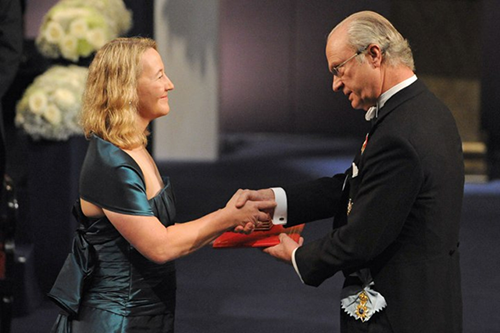
沈阳

环球教育代码TS000173
欢迎来到环球教育官方网站,来环球,去全球,名师高徒,高分留学!
来源:环球教育
小编:长安 250近来SAT的考试文章仍然是时政类,来自Time 2013年10月的评论板块。如多数时评,主要分析evidence和reasoning,style不是没有,较少且微妙,在紧张的考场氛围可操作性大大降低。下面是环球教育罗柏清老师对文章的分析:
(考试文章不可能如原文长,所以虽然贴了原文,但选了重点来讲)
如何提高女性诺贝尔获奖者数量
How To Increase the Number of Women Winning Nobel Prizes
By Meredith Wadman Oct. 24, 2013

Pontus Lundahl / AFP / Getty Images
The mother of tweens was folding laundry at 5 a.m. before going to an early spinning class when the phone rang. It was October 2009 and Carol Greider, a biologist at Johns Hopkins University, picked up and heard a voice from Stock-holm. She had won that year's Nobel Prize in medicine.
evidence-开篇一个场景描写,展现了女性诺奖得主的给宝宝叠衣服的日常,吸引读者注意力,并为下文做铺垫。(personalized language, vivid imagery, a nice lead, set the tone of the article)
Unfortunately, Greider remains a rarity in the pantheon of Nobel scientists. And that's partly because we haven't done enough to help young female scientists balance the demands of academic research with the pull of family responsibility. That needs to change.
Admittedly, today's situation is better than it was when Greider entered grad school in the early 80s, never mind in the dark days of the preceding decades. Then, when women were scarcely to be found at undergraduate lab benches, the results in the rarefied reaches of Stockholm couldn't help but be dismal. Since the awards were launched in 1901, two physics laureates have been women: Marie Curie in 1903 and Maria Goeppert Mayer in 1963. In chemistry, four of the 165 winners have been women. (Marie Curie was one of them, in 1911; she is the on-ly woman to have won two Nobels.) Women have won 5 percent of the coveted awards in physiology or medicine. And it was 2009 before Elinor Ostrom, of IndianaUniversity and Arizona State University, became the first-ever female laureate in economics.
reasoning-从现在追溯女性诺奖得主历史。
evidence-1来historical fact,阐明女性获奖者寥寥。2来statistics来佐证。这一段简直是送分!
…
To be a female Nobel winner has not only required brilliance, but also preter-natural determination in the face of cultural, social and political obstacles. The Italian neurologist Rita Levi-Montalcini secretly conducted experiments in her bedroom in Mussolini's Italy. Francoise Barre-Sinoussi, the Parisian who co-discovered the AIDS virus - and whose father thought a women's place was in the home - was in the lab on her wedding day. Her fiancé had to call her to re-mind her to turn up at the ceremony. Barbara McClintock, the U.S. geneticist who won the prize in 1983, was nearly prevented from attending college by her mother. She was afraid higher education would make her daughter unmarriagea-ble.
evidence-更纯粹的historical fact,证明女性科学家之艰辛,究其原因?第一句话-文化,社会和政治的阻碍。例子呈现了非常强烈的画面感(imagery),比如在卧室做实验,婚礼当天还在实验室,差点因为妈妈觉得嫁不出去不让读大学。这些concrete examples能给人强烈的代入感,留下深刻的印象。
All of this was decades ago, before recent campaigns to encourage more young women to choose STEM (science, technology, engineering and math) careers; and, in the US, before the Civil Rights Act, affirmative action and Title IX. What's the excuse in 2013?
承接上一段,通过历史拷问现实。引出下文诺奖女性得主少的原因。
One partial explanation for the bleak numbers: the awards often honor discover-ies made decades earlier. Even today, that means spotlighting accomplishments from a time when female scientists were a rarity. Take the 2013 prize in physi-ology or medicine, which was awarded earlier this month to James Rothman, Randy Schekman and Thomas Südhof for their work teasing out the micro-mechanisms that allow cells to transport their molecular cargo to specific destina-tions. Their key papers in this area were published between 1979 and 1993.
reasoning-原因1是表彰滞后,90年代发现1013年才颁奖。(画外音:这效率...)
evidence-example
Still, while it may be tempting to conclude that just a little more patience is re-quired before a raft of lady laureates take Stockholm by storm, it's important to note that promising numbers in biology where by 2010 U.S. women were collect-ing 53 percent of PhD's don't translate to other disciplines: that same year, women earned 39 percent of chemistry PhD's, 34 percent of economics doctor-ates and 20 percent of PhD's in physics.
reasoning-这里终于出现了驳论(refutation/challenge assumption)的手法:'你以为再多点耐心就好了?想太多。'
evidence-凭什么这么说?数据扔给你,接住!送分题再次出现。
What's more, systemic issues are holding women back across the sciences, mean-ing that we may not see more female laureates by simply funneling more and more women through PhD programs. The hard truth is that women with brand new doctorates - so called post-doc's - enter their prime childbearing years ex-actly as they encounter the make-or-break time when they must compete for ten-ure- track positions. The competition is brutal, the hours in the lab never-ending - and the attrition of women is far higher than that of men. A 2009 survey of post-doctoral scientists from all disciplines in the University of California system found that women who had children after they earned PhDs were twice as likely as male postdocs - or as women doctorates with no children and no plans to have them - to drop their goal of becoming a research professor.
reasoning-原因2是系统性毛病,在职业生涯最为关键时期的博士后期间,女性需要生育。联系下原因1,说作者多摸缜密,竟然想得到2个原因诶!!
evidence-调查(research),是不是太简单了点啊?
What, specifically, should institutions do to offer such support? Universities can make meaningful policy changes, such as allowing women with young children to stop the tenure clock for a period of time - an option available at some but not all academic centers. They should ensure that young female scientists have dedi-cated, top-notch mentors. And they can guarantee paid maternity land parental leave-something that's woefully lacking for junior scientists at most U.S. insti-tutions.
Reasoning-方案1针对机构(institution)
某些评论文章只负责挖坑,但是CB这么好人,想让你多拿点分,快快联系一下原因,说作者真的好棒哦,竟然知道不但要暴露问题,还要提出解决方案啊!
Federal agencies also have a role to play. Big funders, led by the National Insti-tutes of Health (NIH) have already implemented policies like no-cost grant exten-sions that allow scientists with family obligations extra time to complete a pro-ject, and others that allow fellowship periods to be extended or deferred for childcare purposes. But agencies can, and should, do more. One task the gov-ernment is especially suited to is longitudinal data collection on those family-friendly policies. Such data isn't being collected systematically, and without it we can't know what policy changes are working, and which ones aren't.
Reasoning-方案2针对联邦政府(federal government)
If we want top-drawer women to stay in science careers - and this country, be-set by daunting, and growing, global science competition, could certainly use them - institutions of all stripes need to show a far more serious commitment to supporting them.
To put it another way, if we want to see more women celebrating in Stockholm, we should strive to build a world in which the likes of Carol Greider are hardly ever to be found folding the laundry at 5 in the morning.
Reasoning-最后2段总结全文,呼吁各机构拿出决心,付诸行动。
Evidence-最后一段写的尤其好,呼应(echo)第一段诺奖得主叠衣服的画面,有了一个很好的closure,意味深长。
当然style也是可写的,比如从风格看imagery,个性化的场面描写不流于空泛,给读者强烈的共鸣(resonance),appeal to emotion.
小结:
reasoning-历史和现实的对比,原因和方案,立驳结合。
evidence-数据,调查,画面描写,史实。
最后谈谈作文结构:
OG范文,大部分reasoning和evidence分开写,但是kaplan练习题里面,也不乏合起来,按文章展开顺序来写的。前者对总结能力(阅读速度)要求稍高,后者则可以通读一遍,对分析重点心中有数,第2遍读时边读边写。本来一篇文章的论点论据就是融为一体的,等我睡一觉,写篇范文来,今晚就酱~